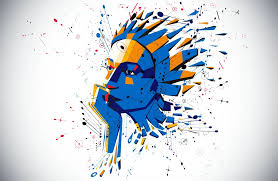In today’s digital-first world, graphic design is more than just an art—it’s a language, a profession, and a powerful tool that shapes how we communicate visually. From social media campaigns to branding for global businesses, the impact of visual design is everywhere. If you’ve ever been curious about creating stunning visuals, telling stories through imagery, or launching a creative career, enrolling in a graphic design course might just be the perfect start.
In this blog, we’ll explore what a graphic design course entails, who it’s for, what you can expect to learn, and how it can lead to exciting opportunities—whether you’re a student, entrepreneur, or aspiring creative.
What Is a Graphic Design Course?
A graphic design course teaches you how to communicate ideas and messages visually using tools like typography, imagery, layout, and color. These courses range from beginner-friendly overviews to advanced certifications focused on branding, UI/UX, or motion graphics.
Typically, you’ll learn how to use design software, develop creative thinking skills, understand design principles, and build a portfolio that showcases your talent.
Types of Graphic Design Courses
- Beginner Courses: Introduction to design principles and tools (Photoshop, Illustrator, Canva).
- Advanced Courses: Branding, editorial design, motion graphics, UI/UX design.
- Specialized Certifications: Adobe Certified Expert (ACE), UX Design, Product Design.
- Online Short Courses: Skillshare, Coursera, Udemy, LinkedIn Learning.
- Degree/Diploma Programs: Offered by universities or design colleges.

Why Take a Graphic Design Course?
Whether you’re starting from scratch or looking to sharpen your skills, here are compelling reasons to consider taking a graphic design course:
1. Learn Industry-Standard Tools
You’ll master design software like:
- Adobe Photoshop – for image editing and compositing.
- Adobe Illustrator – for logos, vector art, and illustrations.
- InDesign – for layouts like brochures, magazines, or eBooks.
- Figma or Adobe XD – for UI/UX design and web interfaces.
A good course doesn’t just teach you how to use tools—it shows you why and when to use them for the best visual impact.
2. Understand the Principles of Good Design
Design is more than decoration. A graphic design course teaches you core principles such as:
- Balance and alignment
- Contrast and hierarchy
- Color theory and harmony
- Typography and readability
- Grid systems and composition
These fundamentals are key to creating effective, engaging visuals.
3. Build a Professional Portfolio
A solid portfolio is your golden ticket in the design world. Courses often include hands-on projects—like branding exercises, poster designs, app mockups, or packaging design—that help you demonstrate your skills.
4. Discover Your Creative Identity
Courses expose you to different styles and creative challenges. You learn how to think like a designer, solve problems visually, and find your personal aesthetic. Over time, you’ll develop your own creative voice.
5. Kickstart a Creative Career
Graphic design is in demand across industries:
- Marketing and advertising
- Tech and product design
- Media and publishing
- Fashion, film, and events
- Freelancing and entrepreneurship
Many course graduates become:
- Graphic designers
- UI/UX designers
- Art directors
- Brand strategists
- Freelance creatives
What You’ll Learn in a Graphic Design Course
While course content can vary, most well-structured programs cover:
1. Design Foundations
- Elements and principles of design
- History of graphic design
- Composition and layout
- Color theory and typography
2. Software Training
- Adobe Creative Suite (Photoshop, Illustrator, InDesign)
- Figma or Sketch for interface design
- Canva or Procreate for digital artwork (optional in some courses)
3. Branding and Identity
- Logo design
- Brand guidelines
- Packaging and marketing collateral
4. UI/UX Basics
- Wireframing and prototyping
- User experience design
- Responsive design for websites/apps
5. Portfolio Development
- Personal and client-based projects
- Presenting and critiquing your work
- Portfolio website creation
6. Freelancing or Career Advice
Many modern courses now include career development: pricing, client work, contracts, and building your personal brand.
Who Should Take a Graphic Design Course?
Graphic design is for everyone with a creative spark and a passion for visuals. Here are a few ideal learners:
- Students wanting to pursue a creative career.
- Entrepreneurs who want to brand their businesses professionally.
- Marketing professionals looking to boost their design skills.
- Freelancers aiming to offer design as a service.
- Hobbyists who love visual arts and want to learn for fun.
No matter your background, a design course can add value to your personal and professional journey.
Online vs. Offline Courses: Which One Should You Choose?
Online Courses
Pros:
- Flexible scheduling
- Learn at your own pace
- Access to global instructors
- Often more affordable
Cons:
- Self-discipline required
- Less personal feedback
Offline Courses
Pros:
- Face-to-face mentorship
- Networking opportunities
- Structured learning
Cons:
- Less flexible
- Often more expensive
Choose the format that best fits your lifestyle, learning preferences, and budget.
How to Choose the Right Course
Here are a few things to consider when selecting a graphic design course:
- Course Content – Does it cover both fundamentals and practical projects?
- Instructor Experience – Do the instructors have real-world experience?
- Software Focus – Are they teaching industry-standard tools?
- Portfolio Development – Will you complete projects you can showcase?
- Reviews and Testimonials – What do past students say?
- Certification – Does the course offer any recognition or credentials?
Conclusion: Design Your Future
A graphic design course is more than a class—it’s a gateway to creativity, communication, and opportunity. Whether you dream of becoming a full-time designer or just want to create better visuals for your business or passion project, the skills you gain are invaluable in today’s visual world.
So if you’re ready to explore your creative side, build a portfolio, and turn your passion into a career, it’s time to take that leap. Enroll in a graphic design course and unlock a world of visual storytelling.